BLUIS stands for 'Bharatalipi Unified Indian Script'. It was devised by Punya Pranava Pasumarty to write Sanskrit, Tamil, and Urdu, and can also be used to write other languages of India. However, by no means is the script intended to replace the age old writing systems of the Indian languages in concern. The script uses very simple glyphs in an intuitive manner to develop the various sounds required for use in Indian languages. The script has the following aims in mind:
Most of the languages spoken in India have scripts running from left to right save those like Urdu and Kashmiri, whose direction is the opposite. For these few exceptions, there is a formal and informal version of BLUIS. Whilst the informal version looks just like any other usage of BLUIS, the formal one is written exactly in mirror image horizontally. Furthermore, the informal script takes pronunciation lightly, while the formal version adheres to the exact phonetics as brought out by the arabic script originally used for these languages.
BLUIS is neither completely an alphabet nor an abugida. The features of the script are the following (refer to image below):
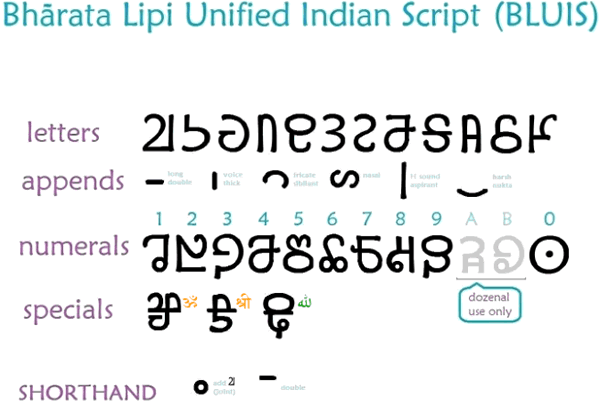
The appends given above are marks that generally combine with letters to develop a variety of sounds by modifying them. The first append is very commonly used and it has the function of extending the sound of the letter it combines to (i.e. it makes vowels long and consonants double). The second append gives a voiced quality to the letter (i.e. it makes vowels semivowels and consonants voiced). The third one is hard to describe. To consonants it gives a fricative/sibilant quality and it makes vowels coarse to sound, sometimes with a fricative effect. The fourth one simply nasalises and voices/lenghtens the letter. The fifth one is unique since it can either stand alone as or combine to a letter. It aspirates a consonant, acts as a visarga following a vowel and has the 'h' sound on its own. The last append is used (mainly for urdu) to make a consonant sound more guttural.
Rarely would one find letters in their pure form since they often combine with one or more appends to develop the wide array of sounds used in Indian languages. A table of the basic letter to append combinations and their pronunciational equivalents in Sanskrit, Tamil and Urdu has been thus provided. Note that this script abides by the pronunciation of sounds in Indian languages and, to that end, would strive to accommodate them.
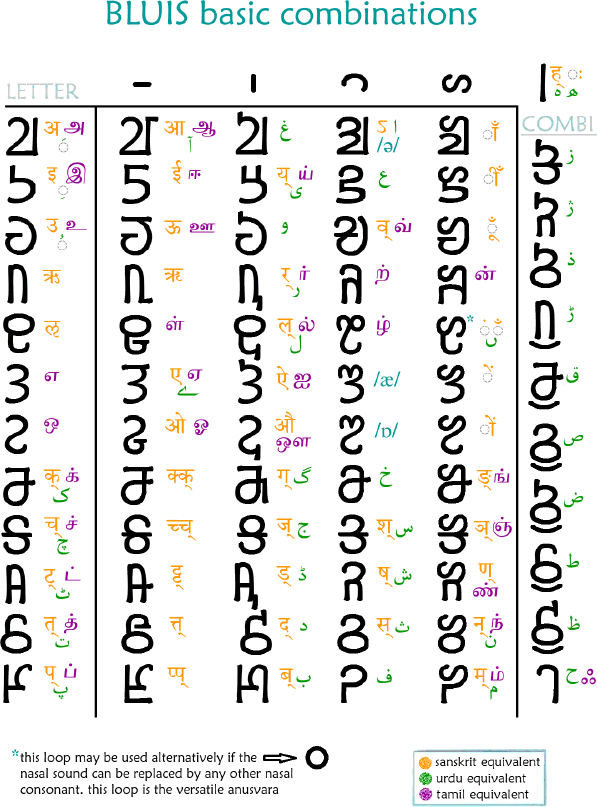
NOTE: these are called basic combinations because one can also use multiple appends on one letter to produce more sounds.
As seen in the image, the basic combination for the anusvara has an alternate glyph (a simple circle), thus respecting its abundant use. This circle can be used only for a nasal consonant sound, but for a ‘candrabindu’ (ँ), ‘nun ghunna’ (ں) or ‘arasunna’ (ఁఁ) sound the original letter must be used. Some ‘further’ combinations have been provided in the COMBI column in this image. These are letters formed by attaching more than one append to a single basic letter to form a new sound. This is an indicative list and there are more such combinations
When writing in BLUIS, there is a convention called the SHORTHAND, mentioned briefy earlier, which is followed for convenience and reducing the bulk of text. As can be seen, there are 2 SHORTHAND provisions:
When writing in BLUIS, there is a convention called the SHORTHAND, mentioned briefy earlier, which is followed for convenience and reducing the bulk of text. As can be seen, there are 2 SHORTHAND provisions:
The manifestation of the former shorthand takes different forms according to the consonant is is joined to as shown in the image below while the latter is uniform for all consonants (which are not already doubled with the second append). For adjoining Sanskrit vowels ‘ ऐ ’ and ‘ औ ’ , which are essentially ‘a’ followed by some vowel, one may use the former shorthand followed by ‘y’ or ‘w’ respectively.
The usage of this convention is, unless mentioned otherwise, mandatory for the sake of simplicity and quick writing of text. It is, however, permitted for one to write without shorthand conventions while learning the script although that compromises on compactness of text. All BLUIS text in this document uses this shorthand because it is the convention.
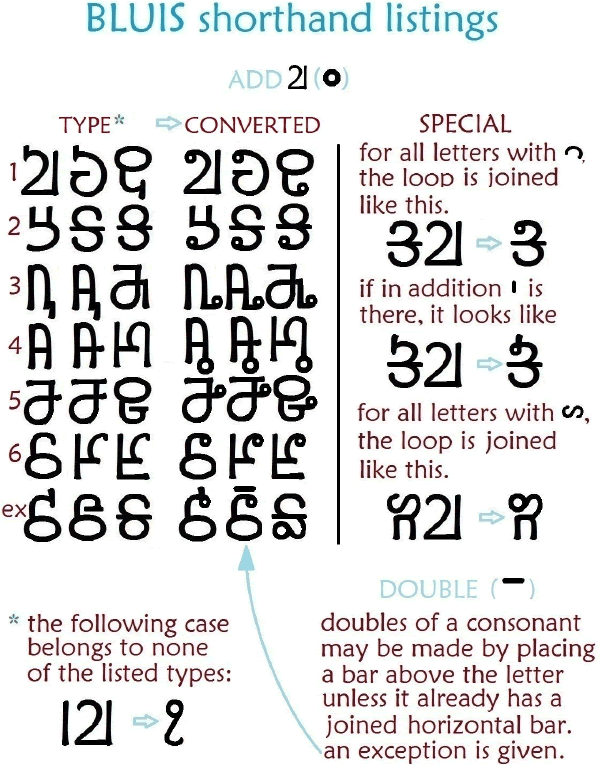
The 'overhead bar' is simply placed above the letter in concern, but the 'joint loop' has several varied ways of combining with basic combination letters as enumerated in this image. There are 'special' rules given above in the SPECIAL column for all letters with the third or fourth appends.
Apart from these, the letters are categorised morphologically into 6 types as seen on the left of the image above. These types determine how the joint loop combines with the letter. For type 1 letters, the loop replaces the vertical dash (second append). For type 2 the loop joins the end of the tail below, and similarly for type 6, the tail above. In type 3, the vertical dash extends horizontally at base level to end in a loop, and in type 5, a similar thing happens at mid-height. To type 4 letters, the loop is simply placed at the bottom of the right vertical stroke. The letters given next to ‘ex’ are exceptions to these types since they follow no rule in combination. Note that one of these exceptions undorgoes a curious change as its horizontal dash (first append) becomes an overhead bar and the joint loop directly combines with the main letter like in type 6. At the bottom of the image a special combination of the fifth append and joint loop is given. This gives the sound of ह . This combination contains no basic letter, but it is treated as a letter in its own right. However if the fifth append is to be used as sanskrit visarga (ँः) or urdu final hae (ہ-), it mustn’t combine with the joint loop by protocol.
An important criterion to consider in BLUIS typography is the dictionary order of the script. In the first image of this document, the basic letters are given in a specific order and so are the appends. This order is adhered to in the dictionary.
When multiple appends combine to one basic letter, the append combined 'earlier' can be determined by its presence among the 'basic combinations'; other appends are added over and above these. If a letter has a joint loop attached it has priority over the same letter without the loop. Note that the anusvara loop has equal priority to its counterpart among the basic combinations (the 'candrabindu' / 'nun ghunna' letter), but if both occur in consecutive dictionary entries (which is rare), then the anusvara loop takes precedence. The fifth append as a standalone letter comes in priority after all basic letters and any letter with the sixth append naturally comes after the same letter without it. These are the basic criteria for BLUIS dictionary order.
Given below is a political map of India with the list of states and union territories given in BLUIS dictionary order. It might help to grasp the dictionary order better.
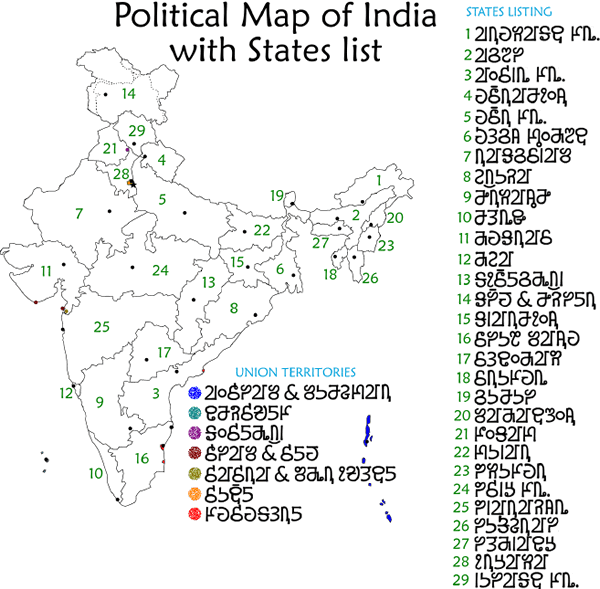
This is a basic map without much of geographically useful data since its purpose is to give an idea of BLUIS dictionary order.
About BLUIS, these are all that a beginner need know to read and write the script. There however are some minor intricacies like any culturally nurtured script has, for example, there is a compound symbol for a sound between 'i' and 'u' which is used in the kashmiri language and appears at the end of many words in colloquial tamil represented by 'u', but those topics are beyond the scope of this document.
By way of concluding this document, article 1 of UNO's 'The Universal Declaration of Human Rights' is given in 4 languages using BLUIS. The Omniglot website bears partial credit to this text.
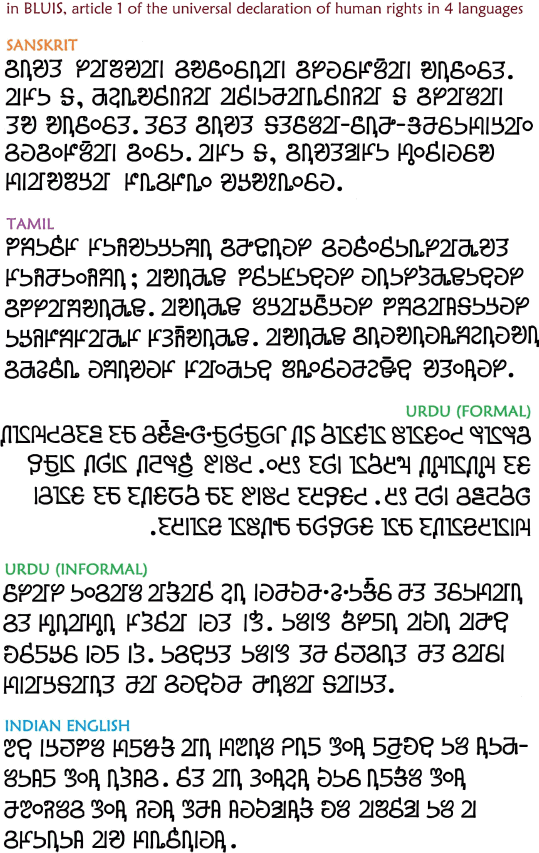



All human beings are born free and equal in dignity and rights. They
are endowed with reason and conscience and should act towards one another
in a spirit of brotherhood.
(Article 1 of the Universal Declaration of Human Rights)
Bhāratalipi Unified Indian Script (BLUIS), Charunagari, Deccan Lipi, Devadeshi, Ethiofarsi, Españabugida, Farsi Alefbet, Featural Lojban Abjad, Haruf-e-Tana, Palimukhi, Neobrahmi, SEAscript, West Eurolex
Constructed scripts for: Ainu | Arabic | Chinese languages | Dutch | English | Hawaiian | Hungarian | Japanese | Korean | Lingala | Malay & Indonesian | Persian | Tagalog / Filipino | Russian | Sanskrit | Spanish | Taino | Turkish | Vietnamese | Welsh | Other natural languages | Colour-based scripts | Tactile scripts | Phonetic/universal scripts | Constructed scripts for constructed languages | Adaptations of existing alphabets | Fictional alphabets | Magical alphabets | A-Z index | How to submit a constructed script
[top]
You can support this site by Buying Me A Coffee, and if you like what you see on this page, you can use the buttons below to share it with people you know.

If you like this site and find it useful, you can support it by making a donation via PayPal or Patreon, or by contributing in other ways. Omniglot is how I make my living.
Note: all links on this site to Amazon.com, Amazon.co.uk
and Amazon.fr
are affiliate links. This means I earn a commission if you click on any of them and buy something. So by clicking on these links you can help to support this site.
[top]